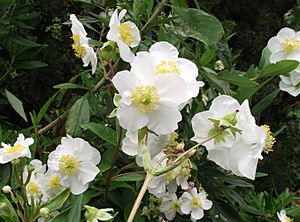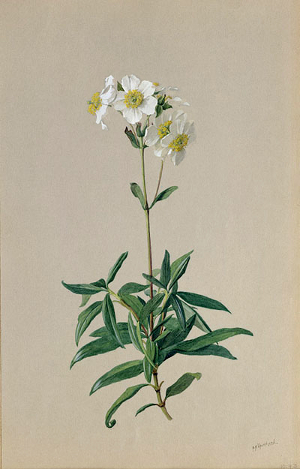Carpenteria facts for kids
Quick facts for kids Carpenteria |
|
|---|---|
 |
|
| Scientific classification | |
| Genus: |
Carpenteria
|
| Species: |
californica
|
Carpenteria californica, also known as the tree anemone or bush anemone, is a beautiful flowering plant. It belongs to the hydrangea family, called Hydrangeaceae. This plant is the only species in its special group, or genus, called Carpenteria. It is quite similar to another plant group called Philadelphus.
The tree anemone is an evergreen shrub, meaning it keeps its leaves all year round. It grows naturally in the Sierra Nevada foothills in California. The genus Carpenteria was named after Dr. William Marbury Carpenter, a famous botanist from Louisiana.
It's important not to mix up Carpenteria with Carpentaria, which is a type of palm found in northern Australia.
Contents
What Does the Tree Anemone Look Like?
Carpenteria californica can grow to be about 1 to 3 meters (3 to 10 feet) tall. Older stems have bark that flakes off. Its leaves grow opposite each other on the stem. They are shaped like a spear, about 4 to 10 centimeters (1.5 to 4 inches) long and 1 to 2.5 centimeters (0.4 to 1 inch) wide. The top of the leaves is shiny green, while the underside is blue-green or whitish and feels soft.
The flowers smell sweet and are about 3 to 7 centimeters (1 to 3 inches) wide. They have five to eight pure white petals and a bunch of bright yellow parts in the middle called stamens. These lovely flowers bloom from late spring to midsummer. After flowering, the plant produces a tough, leathery capsule fruit. This fruit is about 6 to 12 millimeters (0.2 to 0.5 inches) across and holds many tiny seeds.
Where Does the Bush Anemone Grow?
The bush anemone is a rare plant. It grows naturally in only seven places in Fresno and Madera Counties in California. This means it is endemic to these areas. You can find it in chaparral and oak woodlands at heights between 340 and 1340 meters (1,100 to 4,400 feet) above sea level. It grows between the San Joaquin River and Kings River.
This plant is very good at surviving wildfire. After a fire, it can grow back from its stump. New plants growing from seeds are not very common in nature.
Growing Tree Anemone in Gardens
Carpenteria californica is a popular ornamental plant for gardens. People love it for its full leaves, large fragrant flowers, and its ability to handle dry conditions. It is used in traditional gardens and gardens designed for wildlife in places with warm or mild climates in the northern part of the world. It can survive cold temperatures down to about -10°C (14°F) if it's in a sunny, protected spot.
This plant has been grown in gardens since 1875. Today, it is much easier to find in gardens than in its natural home. The first time it flowered in England was in 1885, for a famous gardener named Gertrude Jekyll.
Some special types, or cultivars, of Carpenteria californica include:
- 'Bodnant' — This type can handle colder weather, surviving down to -15°C (5°F) in the British Isles.
- 'Elizabeth' — This one has many smaller white flowers and grows in a more compact shape.
- 'Ladham's' — This type produces very large flowers.
The 'Elizabeth' and 'Bodnant' cultivars have even won the Royal Horticultural Society’s Award of Garden Merit.
See also
In Spanish: Carpenteria californica para niños


